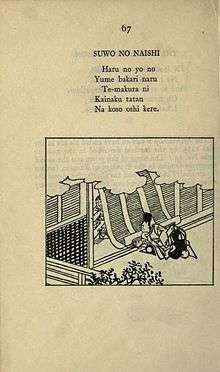Fujiwara no Tadaie
| Fujiwara no Tadaie 藤原忠家 | |
|---|---|
 Tadaie outside the screen | |
| Father | Fujiwara no Nagaie |
| Born | 1033 |
| Died | December 19, 1091 |
Fujiwara no Tadaie (藤原 忠家, 1033 – December 19, 1091), also known as Mikohidari Tadaie, was a Japanese statesman, courtier, politician, poet and calligrapher during the Heian period.[1]
Career at court
He was a minister during the reigns of Emperor Go-Reizei,[2] Emperor Shirakawa and Emperor Horikawa.[3]
Tadaie did well at court, rising to the Senior Second Rank and the office of Dainagon (Major Counselor).[4]
Poet
In this period of Japanese history, the duties of Imperial courtiers included an expectation that each would create and present poems.[5]
An incident from Tadaie's life is featured in a poem which captured a fleeting moment and a gallant gesture:
| Rōmaji | English |
|
|
Calligrapher
Examples of calligraphy attributable to Tadaie are identified variously by the Japanese government as a "National Treasure", as an "Important Art Object" and as an "Important Cultural Property".[7]
Genealogy
Tadaie's grandfather was Fujiwara no Michinaga; and his father was Fujiwara no Nagaie. The son of Tadaie was Fujiwara no Toshitada (1071–1123).[8] This lineage was identified as the Mikohidari lineage within the Hokke branch of the Fujiwara clan.[4]
Tadaie was the grandfather of the poet Fujiwara no Toshinari (1114–1204),[9] who was also known as Shunzei.[10] Tadaie was the great-grandfather of Fujiwara no Sadaie, also known as Fujiwara no Teika.
Notes
- ↑ Museen der Stadt Koln. (1975). "Fujiwara no Toshitada," in Sho : Pinselschrift und Malerei in Japan vom 7.-19. Jahrhundert, p. 84; excerpt, "... Staatsratsmitglieds (State Council Member) Fujiwara no Tadaie ...."
- ↑ Sato, Hiroaki (2008). Japanese Women Poets: An Anthology. p. 122, no. 174.
- ↑ Carter, Steven D (1993). Traditional Japanese Poetry: An Anthology. p. 227, no. 67.
- 1 2 Journal of Asian Culture (1989), Vol. 13, p. 166.
- ↑ Carter, Steven D. (2007). Householders: the Reizei Family in Japanese History, p. 374; excerpt, "... courtiers at the Palace presented poems on the idea of "Enjoying Artificial Cherry Blossoms," at the time of Retired Emperor Go-Reizei"
- ↑ Porter, William N. (1909). A Hundred Verses from Old Japan, being a Translation of the Hyaku-nin-isshiu, pp. 148-149; excerpt, "... [A] lady-in- waiting at the Court of the Emperor Goreizei ... was present one day at a long and tedious court function, and, feeling very tired and sleepy, she called to a servant for a pillow; ... Tadaie, gallantly offered her his arm, with a request that she would rest her head there, and she replied with this verse."
- ↑ Tokyo National Museum, "Essay on Ten Styles of Japanese Poems" (National Treasure) n.b., the manuscript's calligraphy is attributable to Tadaie according to a curatorial note by Kohitsu Ryōsa (1572-1662) at the end of the scroll; compare "Segment from the Michinari Shu Poetry Anthology" (Important Art Object) in "Courtly Art: Heian to Muromachi Periods (8c-16c)"; compare "Record of Various Poem Contests," (Important Cultural Property); retrieved 2011-07-26.
- ↑ Nagako, Fujiwara et al. (1977). The Emperor Horikawa Diary, p. 57; excerpt, "Toshitada was a grandson of Fujiwara no Michinaga's son Nagaie. This Nagaie had been well-known as a poet, and the poetic tradition was kept alive in the family by his son Tadaie and grandson Toshitada. Toshitada's son, Toshinari and grandson Sadaie (Teika) rank among the greatest of all Japanese poets."
- ↑ National Institutes for Cultural Heritage, "Essay on Ten Styles of Japanese Poems" (National Treasure)
- ↑ Keene, Donald. (1999). Seeds in the Heart, p. 681 n2; excerpt, "... the Sino-Japanese versions of their names were used by their contemporaries, and this practice is still observed."
References
- Porter, William N. (1909). A Hundred Verses from Old Japan, Being a Translation of the Hyaku-nin-isshiu. Oxford: Oxford University Press. OCLC 475094624
- Sato, Hiroaki. (2008). Japanese Women Poets: an Anthology. Armonk, New York: M.E. Sharpe.ISBN 9780765617835; OCLC 70131159